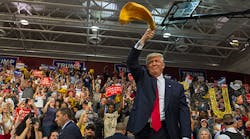The fiscal stimulus plan President-elect Donald Trump and congressional Republicans hope to pass in 2017 is intended to increase real economic growth. But fiscal stimulus doesn’t exactly create growth. It creates demand. Whether demand leads to real growth depends on factors out of the government’s control: productivity and the labor force.
While real growth in the gross domestic product during this economic cycle has been lower than it was in past cycles, the drop in unemployment has surprised people for being as rapid as it has. Even with real GDP growth that has averaged only around 2.1% during this recovery since 2010, the unemployment rate has fallen sharply, from a peak of 10.0% in October of 2009 to 4.6% last month. Even in the slowest year of economic growth of this cycle, 2012, with 1.3% real GDP growth, the unemployment rate fell 0.6%.
Now policy makers face a challenge. At 4.6%, the unemployment rate has already beat the Federal Reserve’s longer-run forecast of 4.8%. When the labor market is so tight, how much more growth is possible? If GDP growth of around 2% has been enough to lead to a steady drop in the unemployment rate, sustained growth of 3% to 4% would drive it down to levels we haven’t seen in decades, and far below levels the Fed believes are sustainable.
Two variables could give the economy more of a growth runway: labor force growth and productivity growth.
One of the reasons the unemployment rate has fallen so quickly despite sluggish GDP growth has been relatively low labor force participation. The “prime age” labor force participation rate for people ages 25 to 54 fell from 83.1% in December 2007 to a low of 80.6% in 2015. Since then, it has recovered somewhat, to 81.4%. The drop in the participation rate for people ages 20 to 24 has been even larger. Should their participation rates increase, and should baby boomers decide to work a little longer, that would allow the economy to grow faster without driving up wages and prices too far.
While the path to higher labor force participation seems straightforward enough — higher wages in theory should mean higher participation — tackling productivity growth is trickier. Nobody really knows the best way to increase productivity growth. If we did, everyone would do it. Is it more trade deals, outsourcing and globalization? More automation? More capital spending? More government research? Is productivity growth simply at the mercy of unpredictable booms of technological innovation?
What we know is that productivity growth has been low since the last recession — one of the main reasons for subpar economic growth in general — and that without an increase in productivity growth, a sustained campaign of fiscal stimulus could end up creating more inflation than growth.
While the incoming Trump administration is sometimes compared to the Reagan administration, when it comes to the economy the two have faced opposite problems. Reagan came into office with high unemployment, high inflation and high interest rates. His economic team sought to tackle the supply side of the economy by cutting taxes, regulations and government spending, aiming to reduce bottlenecks on the production of goods and services.
Trump, on the other hand, comes into office with low unemployment, low inflation and low interest rates. His voters weren’t animated by lower inflation and taxes, but rather by the prospect of more jobs and growth. So his team will be focused on stimulus to generate demand — but will that lead to growth?
If it does, Trump may be hailed as the president who got isolated and disconnected Americans back to work, and who restored productivity growth to its pre-recession levels. If it doesn’t, he may create an inflationary mess for the Fed to clean up — a legacy less reminiscent of Reagan than of Carter.
By Conor Sen



